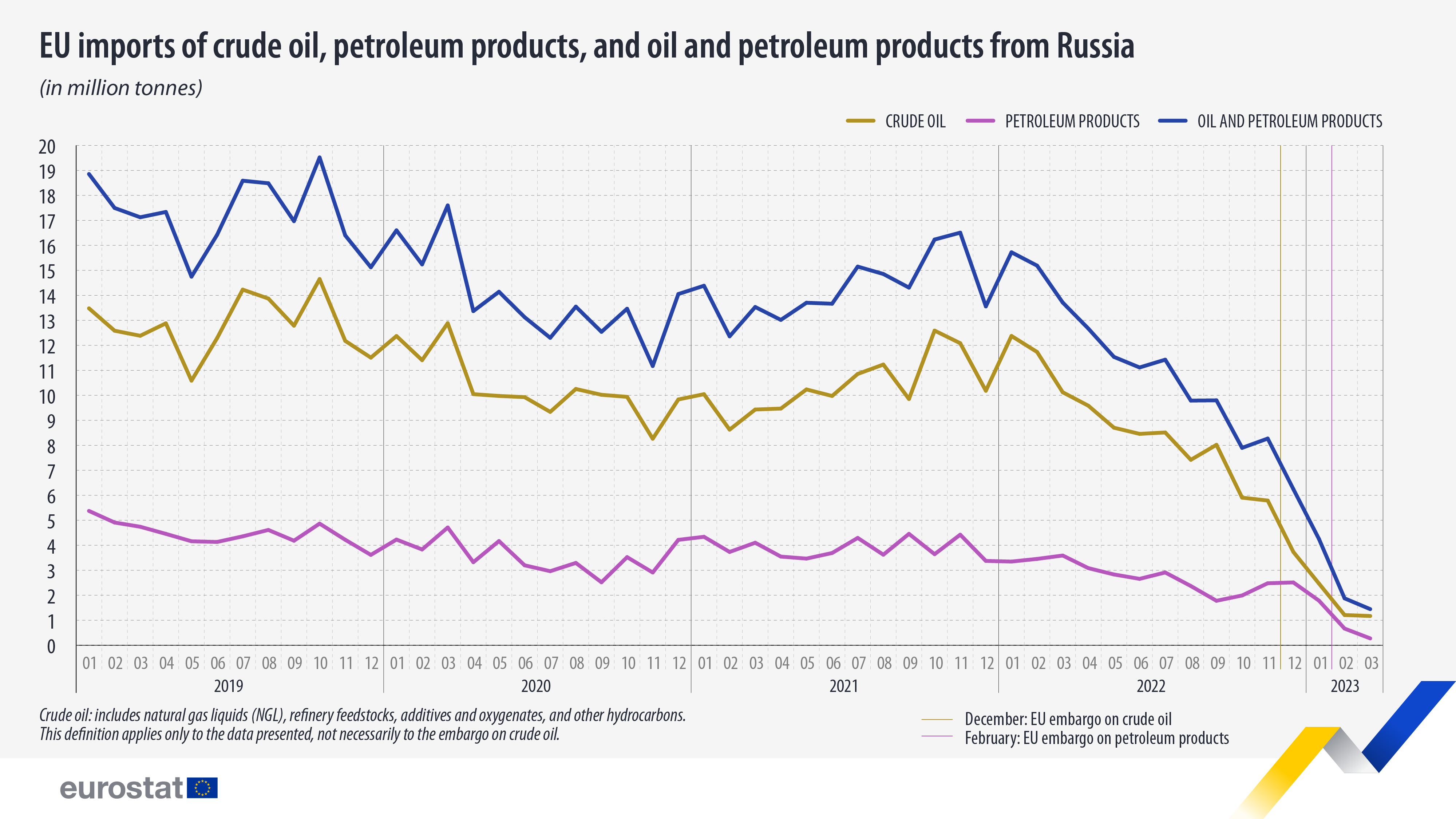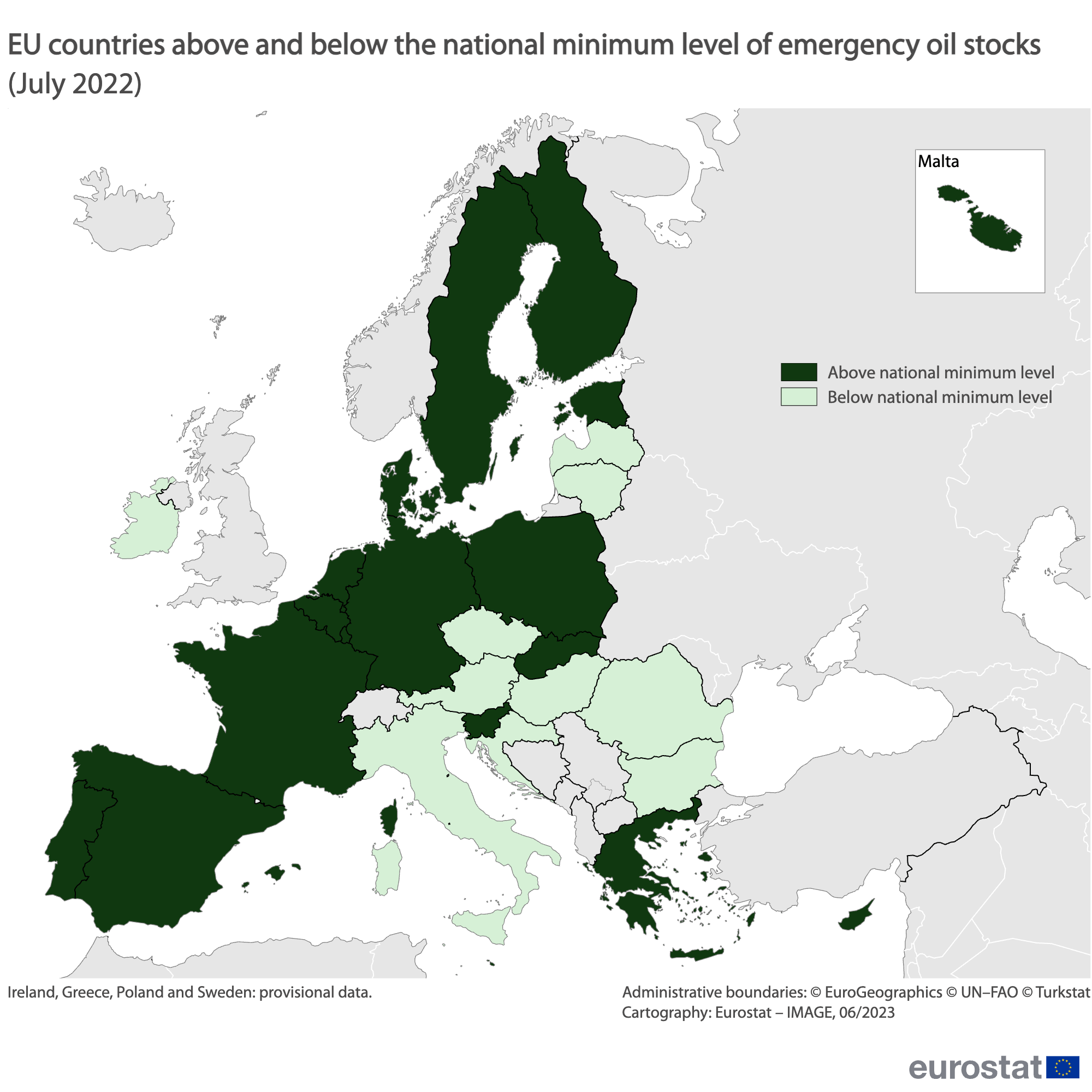Mar '23: EU slashes Russian oil; emergency stocks up

In March 2023, the total imports of crude oil and petroleum products from Russia into the EU decreased to 1.4 million tonnes (Mt) compared with the average monthly figure of 15.2 Mt in the three years from 2019 to 2022 (-90%).
Russia had been a significant source of oil for the EU, but its war of aggression on Ukraine prompted the Commission to issue a 6th package of EU sanctions (June 2022) which included embargoes on imports of Russian oil into the EU. The ban on imports of seaborne crude oil entered into force on 5 December 2022, while the ban on petroleum products took effect on 5 February 2023.
The EU had started shifting its imports to other origins already before the embargoes entered into force and then accelerated the shift to meet the embargoes’ deadlines.
Source dataset: ngr_ti_oilm
Crude oil imports decreased from 12.4 Mt in January 2022 (before the start of Russia’s war of aggression on Ukraine) to 3.7 Mt in December 2022 (-70%), when the embargo entered into force. Crude oil imports continued to decline to 1.17 Mt in March 2023 (-91%).
Meanwhile, imports of petroleum products decreased from 3.3 Mt in January 2022 to 0.7 Mt in February 2023 (-80%), the second embargo deadline, and continued to decrease to only 0.3 Mt in March 2023 (-92%).
Total oil imports from Russia did not reach zero due to certain exceptions outlined in the bans, which allow for limited imports under specific conditions.
Emergency stock releases and EU’s replenishment approach
The Russian war of aggression on Ukraine created turmoil in the oil sector, prompting two emergency stock releases in March and April 2022 aimed at stabilising the market. These were coordinated by the International Energy Agency and backed by the EU.
Several EU countries participated in the joint actions, using part of their surplus of emergency reserves, while others dipped below the minimum levels required under Article 3 of Directive 2009/119/EC.
In 2022, the Commission assessed the situation in the domestic and international markets and advised EU member states to refill their emergency oil stocks to the minimum required levels by 31 March 2023.
Source dataset: nrg_stk_oem
In July 2022, 10 EU countries were below their national minimum level (Bulgaria, Czechia, Ireland, Croatia, Italy, Latvia, Lithuania, Hungary, Austria and Romania). However, by March 2023, only Bulgaria, Czechia, Ireland, Latvia and Lithuania remained below their requirements, and 3 are close to fully restocking their oil reserves.
For more information
- Statistics Explained article on energy statistics – latest trends from monthly data
- Statistics Explained article on emergency oil statistics
- Thematic section on energy
- Database on energy
- Thematic section on the impact of the war in Ukraine
- News article on emergency oil stocks being at lower levels after releases
- Statistics 4 Beginners on energy
- EU sanctions against Russia explained
- EU solidarity with Ukraine
Methodological notes
- Crude oil: includes natural gas liquids (NGL), refinery feedstocks, additives and oxygenates, and other hydrocarbons. This definition applies only to the data presented, not necessarily to the embargo on crude oil.
- EU countries must maintain emergency oil stocks equal to 90 days of net imports or 61 days of consumption, whichever is greater. The method for calculating the obligations can change every year in July. From July 2022 to June 2023, the net imports method applied to all EU member states except for Denmark, Estonia, and the Netherlands, for which the 61 days of consumption method applied.
- Ireland, Greece, Poland and Sweden: provisional data on emergency oil stocks in July 2022.
If you have any queries, please visit our contact us page.


